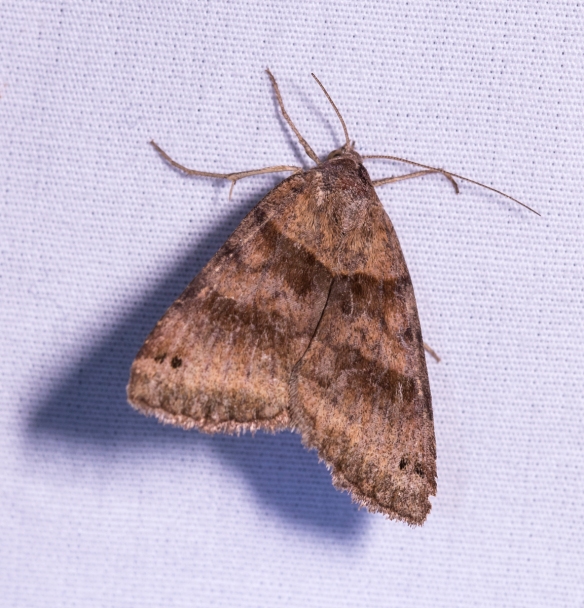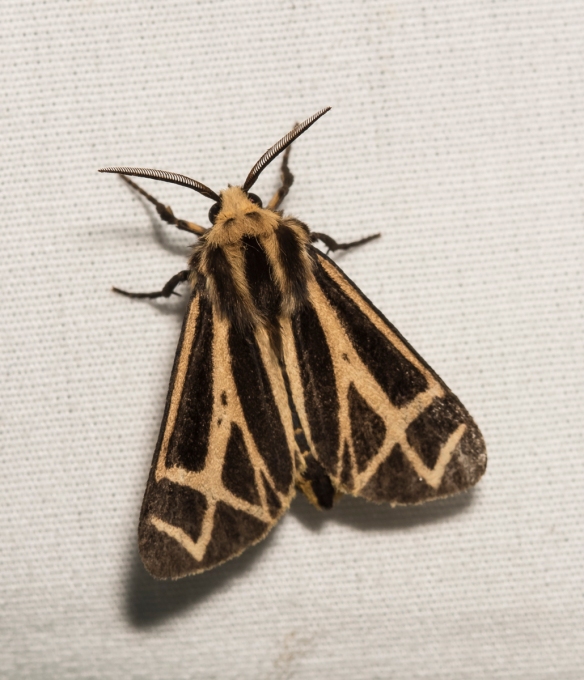It is looking at things for a long time that ripens you and gives you a deeper meaning.
~ Vincent van Gogh
If Van Gogh is correct, then I am ripe and have found deeper meaning, at least as far as mothing is concerned. On the final night of National Moth Week, 2015, I set up the moth light on a farm gate at my parents’ home in the mountains of southwest Virginia. The habitat is very different from where I live. Besides being near the mountains and a river running out back, there is a lot more open ground than I have in my Chatham County woods. In fact, it is mostly open pasture that Dad mows for hay twice each summer. I set the UV light and sheet up along a line of trees that separates their lawn from the pasture. I really wasn’t expecting the kind of diversity I saw in my wooded yard, but wasn’t really sure what might attend the moth party.
As I had anticipated, the nearby river provided plenty of insects that spend part (or most) of their lives in the river. Several Caddisflies and numerous white Mayflies were early arrivals at the party. I was hoping for some Dobsonflies, but they were no-shows. The first couple of visits to the light showed that I was probably correct – the moth diversity, at least of those large enough for me to even attempt to identify, was much less than in the woods at home. But, there were some beetles and lots of tiny flies, and what looked like very small wasps.
There were also plenty of small moths, some of which turned out to be quite beautiful (or strange, depending on your perspective I suppose) when you take a closer look. Not surprisingly, almost all the ones I could identify are found primarily in grassy habitats, and their larvae feed on grasses. The name of one group reflects that – the Grass-veneer moths. I suppose the veneer part of the name comes from their habit of tightly clinging to grasses (usually the underside) during the day, making them tough to find unless you flush them out as you walk.
One Elegant Grass-veneer perched on my tripod next to one of the small bolts. That bolt is probably less than a half inch across so that gives you some idea of the small size of this individual. They are also distinctive in that this group tends to have long labial pals, giving them a snout-like appearance. The palps presumably function as sensory receptors of some sort.
Below are a few other species I was able to tentatively identify by flipping through my field guide and online resources. As always, any confirmations or corrections are welcome as this beginning moth-er finds it challenging.
On my last check of the sheet that night, there was a new grou of moths represented – the Tiger Moths. There were at least 6 of these boldly pattered, medium-sized moths on the sheet. I recognized the group but when I started to try to identify to species i was amazed at how similar some of them are. So much so that Bug Guide let me off the hook in trying to nail down a species identification with this statement about the difficulty of identifying some related species in this group…The only full-proof method is dissection and examination of genitalia.
Well, then, Vincent, time to call it a night I suppose. I am not sure I am that ripe or looking for that deep of a meaning quite yet.










Loving all these moths!
Me too, but so much to learn…
I am enjoying the moth series, and covet your time in southwest Virginia. Trying to head home there myself in the next few days.
Thanks, Julie. A beautiful region, for sure. Enjoy your visit!